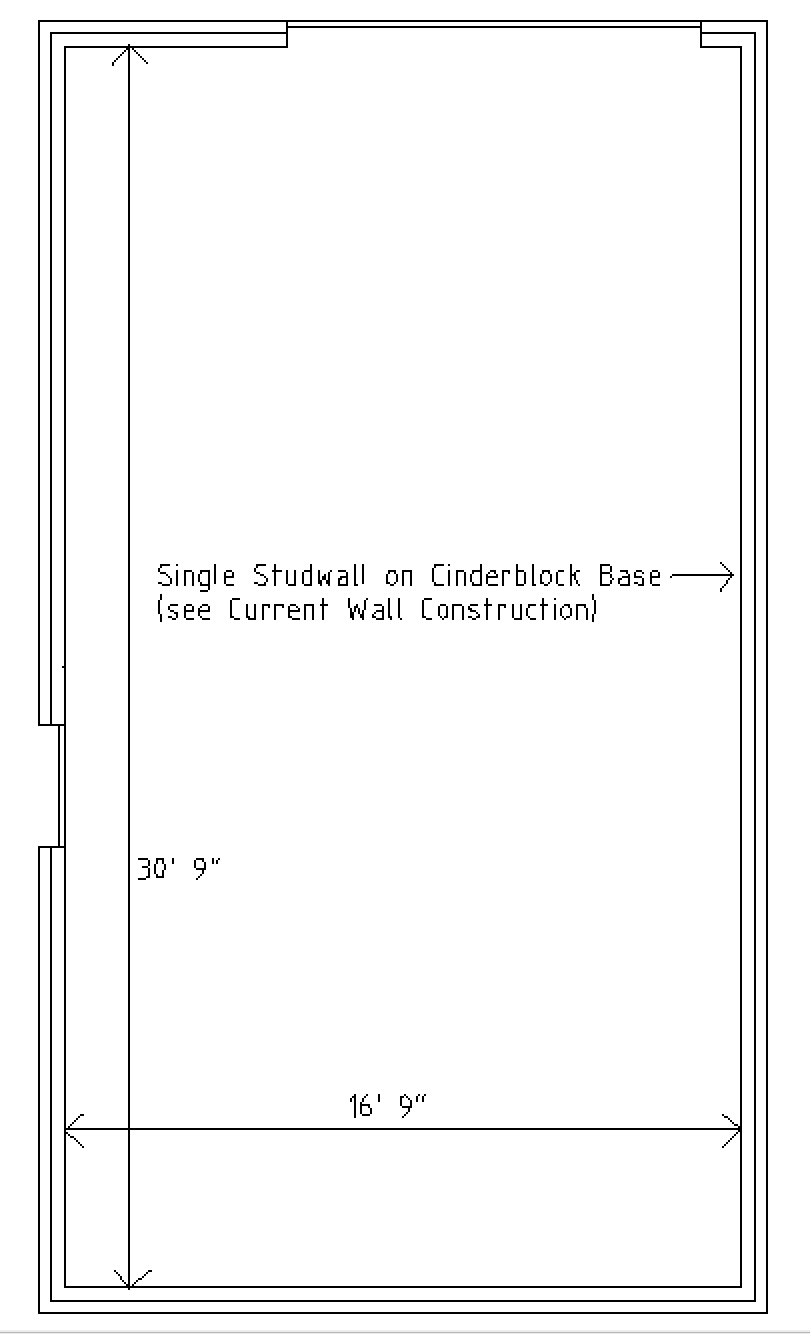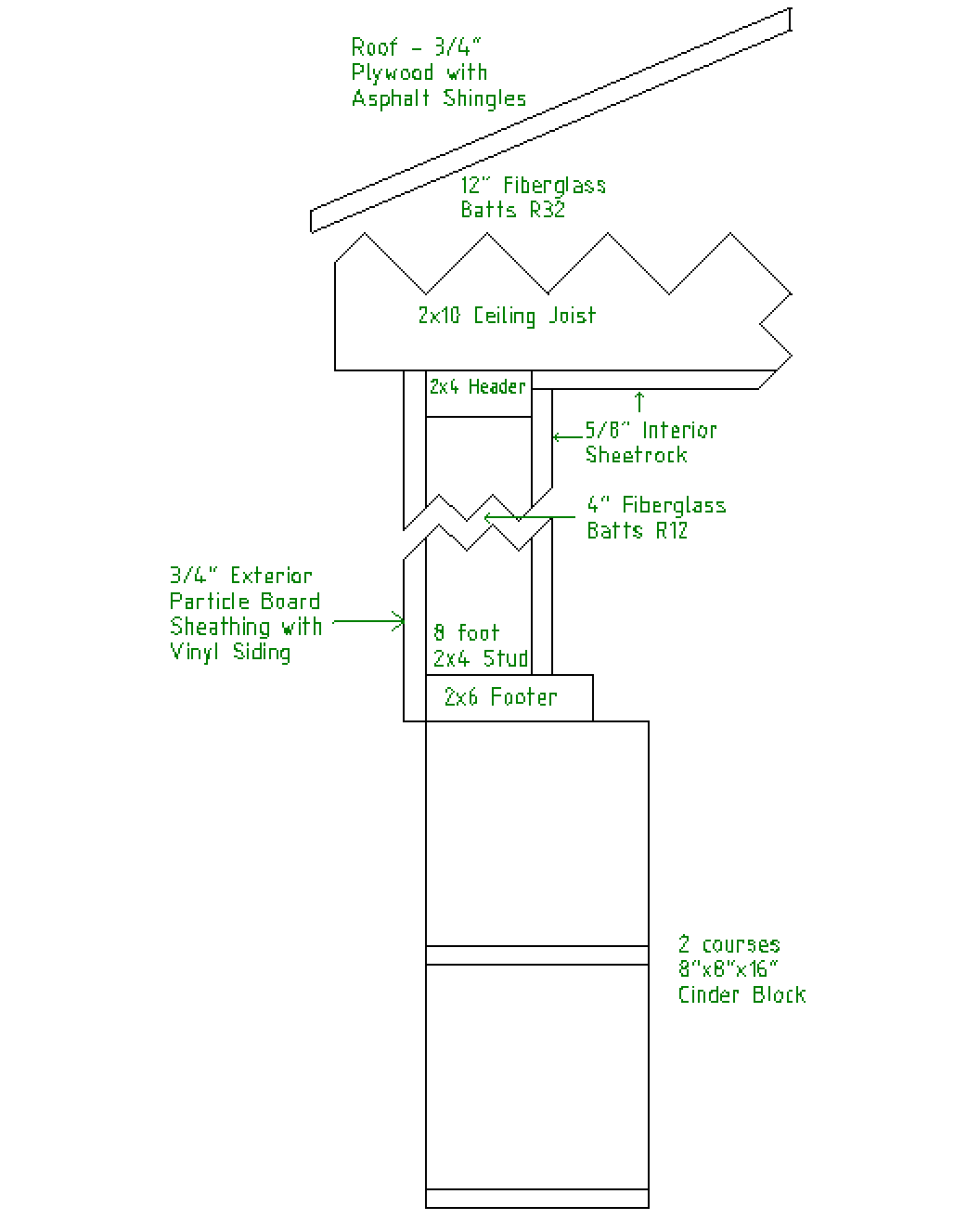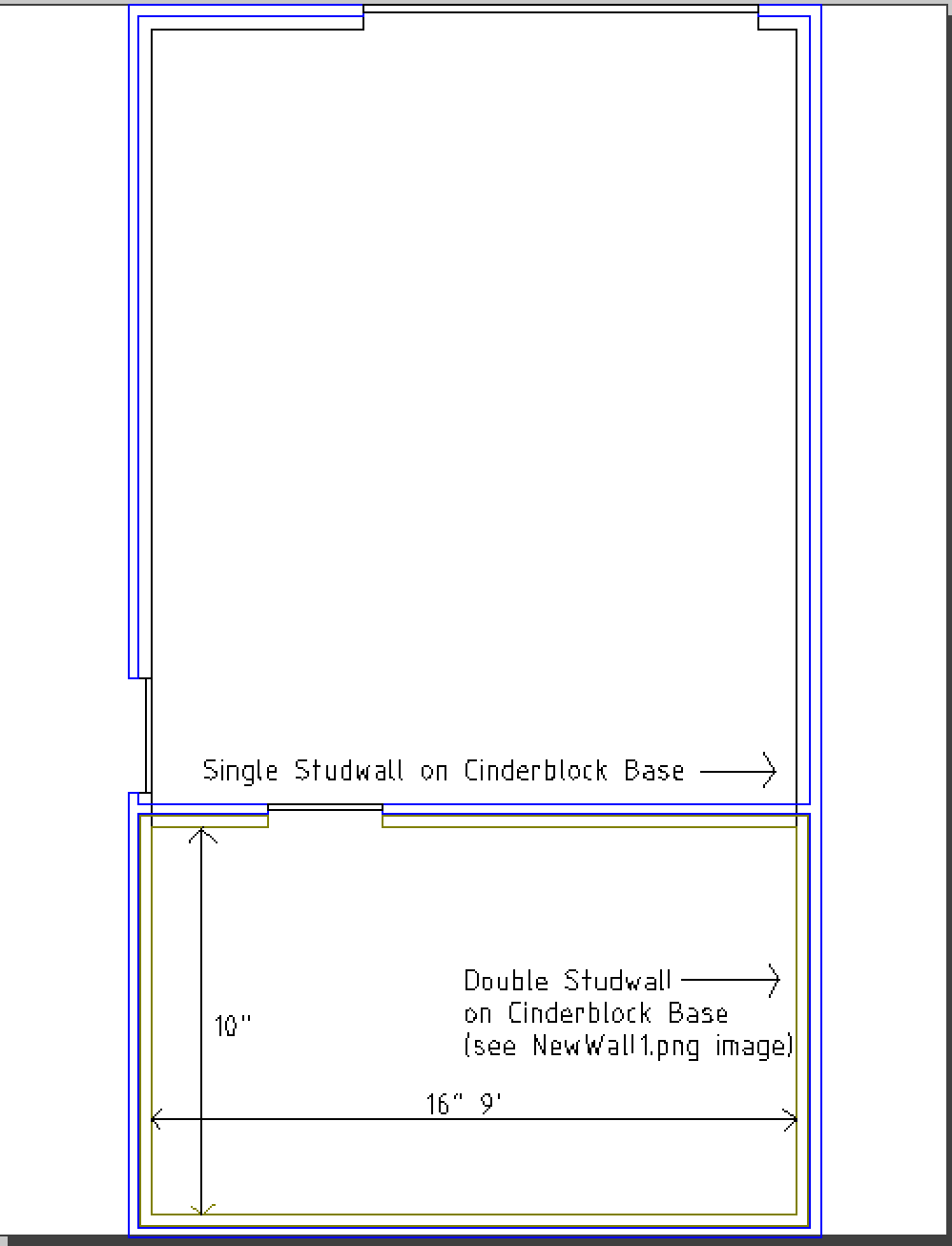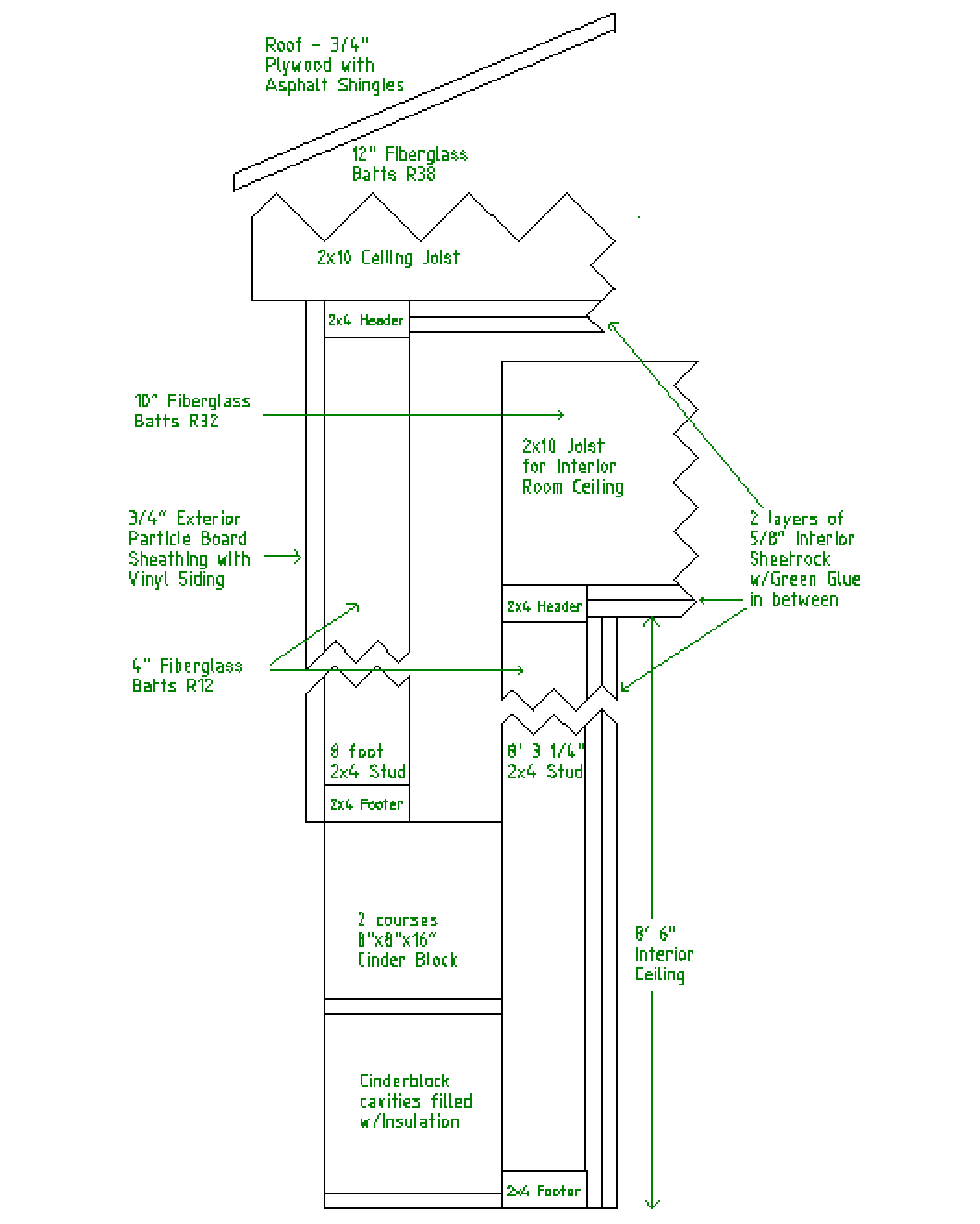Thanks to all on this forum for providing advice and expertise! I've read "Home Recording Studio Build It Like the Pros" a couple times now and I'm moving along with plans for a small room in a detached garage. I'm at the point that I have one immediate question about exterior wall mass, and I would of course appreciate any comments or suggestions. I will attach some 2D CAD drawings (I'm using LibreCad) and I hope everything will be clear. Here's the background...
The Existing Building:
An existing 30' 9" x 16' 9" x 9' 6" detached garage in Minneapolis. The building has both gas and electricity. The image CurrentFloorplan.png shows the existing footprint.
The current wall construction has 2 courses of cinderblock, with 8' stud walls on top. The floor is a standard concrete slab. The stud walls have standard 3/4" exterior particle board sheathing with vinyl siding on the outside and one layer of 5/8" sheetrock on the inside, as shown in the image CurrentWall.png.
Ambient Noise Considerations:
We are in a relatively quiet city neighborhood. If I'm reading my SPL correctly, the ambient noise level (traffic, kids playing lawn mowers, etc) is about 55 dB. The building is 35 yards from a road that has city bus traffic, which causes some rumbling, but the real issue is the fact that we live under the MSP airport flight path. On clear days, when the planes are coming in high, this causes spikes up into the 65 dB range. When it is overcast and the planes come in under the clouds (and the clouds reflect the sound down) we get spikes well into the 70's. When a C-130 transport comes in under the clouds (fortunately a rare occurrence), it is seriously loud - like well into the 90's. I would like to be able to have a 4 piece band with drums, bass and 2 guitars rehearse without bothering the neighbors (about 40 yards away).
The Planned Changes:
The plan is to partition off the back 10' x 16' 9" x 8' 6" area for a practice/casual recording space, leaving the front 20' 9" x 16' 9" x 9'6" area as a garage. The image NewFloorplan1.png shows the planned change.
The new wall construction is planned to have 2 stud walls on the cinder block base. The cinder blocks are 7 5/8" wide, and the stud walls are 3 1/2" wide, so there will be a 1/8" gap keeping the two stud walls from touching. The total cavity would then be 7 5/8". The walls will have 3/4" particle board on the outside (however, see immediate question below) and 2 layers of 5/8" sheetrock with green glue in between on the inside. The ceiling will have the roof (3/4" plywood) and two ceilings with 2 double layers of 5/8" sheetrock with plywood on each of two ceilings, with a 12" cavity. The image NewWall1.png shows this construction.
Alternatively, the second (interior) stud wall could be moved from the stud wall to the slab, increasing the gap between the stud walls to 4 1/8" and the cavity to 11 1/4". The images NewWall2.png show this change.
Questions:
Immediate question: Since the exterior walls are the same for both the NewWall1.png and NewWall2.png construction, what can I do to the exterior walls to increase the mass? Would there be much benefit in adding another layer of 3/4" particle board? Green glue is not recommended in between layers of particle board. The reason this question is immediate is that I need to put new siding on the exterior of the building this fall, but the interior construction will be done over the winter/spring.
Non-immediate question: Does NewWall2.png provide very much (if any) advantage over NewWall1.png? Shaving 4 inches off the entire perimeter of the room reduces the size of the room by a surprising amount, so I kind of prefer the construction with both stud walls mounted on the cinder blocks.
Thank you in advance for your feedback. Please let me know if there is any additional information that I should be providing.
Comments
I'm confused by your two ceilings statement. You want 2 walls/c
I'm confused by your two ceilings statement. You want 2 walls/ceilings to total. Otherwise you have a 3 leaf system, which decreases isolation.
You got
roof- leaf 1,
studio ceiling- leaf two.
Add mass to the roof and new ceiling, and remove the existing drywall on the existing ceiling carefully, and use that to pack the wall and roof bays. Then add some thick fluffy R- value insulation to/above the existing ceiling joists, which are now open/exposed. Build your new ceiling underneath and a support it with the new walls as you depicted.






Hey there. Thanks for the detailed question, planning, and dill
Hey there. Thanks for the detailed question, planning, and dilligent assembly, is the key to good results.
You want to build your walls, with at least a 1" air gap between them. This moves your wall to be anchord to the foundation floor, as in your second illustration of the wall detail. Beyond that, there would be load bearing concidertions with the wall blocks being adaquate enough to support the new walls and ceiling. A stuctural engineer would need to confirm this. Also, building on the wall blocks makes it a single wall assembly where the blocks are, and you may exceed the performance of a singke block wall, with a massive double wall assembly. It also gets more complicated when considering mounting outlets, floor to ceiling bass traps, ect. This would require extra iso mounts for som things. A single massive concrete block wall operates fundamentally differently from a double framed (2 leaf), mass-air-mass assembly.
Keep it simple, do the inner leaf on the foundation floor, spaced 1" off the concrete blocks. Anchored to the foundation floor. Use the gap behind it to run wires, ducting ect. Maintain the air gap/physical decoupling.
If those blocks are hollow, fill them if possible, this will block more sound, and lower the resonant frequency of the assembly even more.
Any additional space between the two wood walls, works to your favour, as it lowers the resonant frequency of the assembly, good for those low rumbles!
I'd really consider increasing the size of of your studio. Add musicians, gear, furniture, and acoustical treatment, and the studio shrinks to an uncomfortable degree.
As simple 2" rigid fiberglass panel spaced off the wall 2" on both ends, eats 8" off your total dimension. Thats minimal treatment.
As far as beefing up the exterior, adding another 3/4" layer doubles the mass giving you an additional 6db of attenuation.
I'd verify Green Glue can't be used, as I've seen builds where rod incorporates GG when using OSB (oriented strand board) as the first layer, with 5/8 drywall for the rest. Osb is a common exterior sheathing, and sometimes refferred to as particle board, even tho particle board is something different. It's sawdust and glue mixed together into a sheet.
The next course of action to add more mass to you external wall assembly, is to add layer(s) of 5/8" firecode drywall in between the wall bays, along with the back rod and non hardening caulking (butyl, silicone), as detailed in the book where it depicts adding mass to an existing basement ceiling. The same principals apply to walls.
The anount of mass you need is limited by the load bearing of the wall, the cavity depth and your budget. It is determined by how loud your band is, and how quiet you need it inside and out.